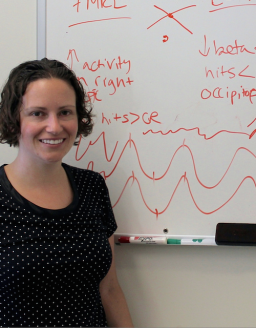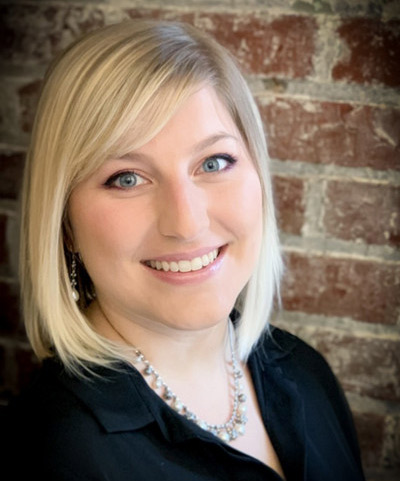Neuroscientist Erika Nyhus Studies Memory, With Hope of Improving It One Day
By Rebecca Goldfine As the population ages and lives longer, the rate of memory disorders is increasing. The National Institutes of Health warn that the number of people with memory impairment could double by 2050. It’s almost inevitable that if you make it to age 90, you’ll have some memory loss, if not an actual memory disorder like Alzheimer’s or dementia. Memory disorders can also crop up in young people who suffer from schizophrenia and depression.
As the population ages and lives longer, the rate of memory disorders is increasing. The National Institutes of Health warn that the number of people with memory impairment could double by 2050. It’s almost inevitable that if you make it to age 90, you’ll have some memory loss, if not an actual memory disorder like Alzheimer’s or dementia. Memory disorders can also crop up in young people who suffer from schizophrenia and depression.
Encouragingly, neuroscientists like Bowdoin’s Erika Nyhus are making headway in understanding how memory works — how our brains make, retain and retrieve memories. The work Nyhus is doing in her lab in the basement of Kanbar Hall could one day lead to better diagnoses and treatments for people with disordered memories. It could also lead to methods for sharpening the memories of those of us who bemoan our own normal but imperfect brains.
At the moment, Nyhus is focused on understanding how different brain regions interact and communicate to conjure up episodes from the past. This kind of autobiographical memory is called episodic memory, and includes contextual information surrounding events from our pasts.
Nyhus, an assistant professor in neuroscience and psychology, became interested in researching memory when she was a graduate student at University of Colorado, Boulder, and saw how much memory interacts with other cognitive processes, including attention, cognitive control and emotion. “Without memory we wouldn’t have a sense of self,” she pointed out.
When we retrieve an episodic memory, many parts of our brain go into action, including the hippocampus, frontal cortex, parietal and temporal regions. “Basically every lobe of the brain [is active],” Nyhus said. “All these regions have areas that function in memory retrieval.”
To better grasp the interactions between brain regions, Nyhus has been inviting student volunteers into her lab to take memory tests. Through the course of the experiment, she or her student assistants measure the electrical activity in the subject’s brain with an EEG.
Later, Nyhus can compare some of the EEG results with MRI brain scans to come up with a picture of how clusters of neurons are coordinating around the brain to share information. While neurons are always active, it’s only when they’re in sync that they can “talk” with one another as they must do to retrieve a memory.
When prompted by a stimulus — e.g., a person wants to recall a memory — a population of excited neurons begins to fire. At the same time, these excitatory neurons activate inhibitory neurons, and the dance in which these two types of neurons engage — they turn on, then off, on, off, etc. — creates waveforms, or neural oscillations.
Nyhus explains this activity by using the metaphor of a phone line. Neural populations are all connected to one another but are not always chatting with one another — in other words, sometimes the line is dead. Only when they begin to oscillate in the same tempo do the lines link up and the neurons begin to perform a mental function. “Neural oscillations are important for these transient communications between brain systems,” she said.
Nyhus has found that two frequencies in particular — the beta and theta frequencies — appear to be important for communications within the memory network. The theta frequencies, which are slower, connect brain regions that are farther apart, while faster beta frequencies connect regions closer together, mostly in the front of the brain. “Theta frequency seems to be important when you’re retrieving old information,” Nyhus said, referring to information that was studied and remembered. Beta frequencies are more prevalent when a person is encountering new information. “These frequencies are involved in memory because they differ when you remember something ‘old’ than when you do not remember something ‘new,'” Nyhus wrote in an email.
In people with disordered memories, these oscillations may be happening, but not in harmony. Some studies have also shown that people with more synchronized oscillatory activity throughout their brain tend to have stronger memory recall.
Nyhus’s work offers hope because when she understands how memory works better, she may be able to transfer this knowledge to devising ways to improve disordered memory systems. At the moment, Nyhus is launching a new study looking at whether lifestyle factors, such as meditation, can change neural oscillations and improve memory. “There is some evidence that mindfulness meditation has cognitive effects, generally in attention,” she said. “Attention affects memory so we would expect to see effects on memory — but no one has studied this in the context of long-term memory.”
She is also interested in pursuing another line of possible memory treatment in which she would investigate whether stimulating the brain with electricity — sort of zapping brains in targeted ways for short amounts of time — could change oscillatory activity and boost memory. “These noninvasive methods might lead to treatment of people with memory disorders,” she said. “We could stimulate people for a week in a lab and see how that changes their brain activity and memory abilities.”
To read about Erika Nyhus’s student research over the summer, go here.


